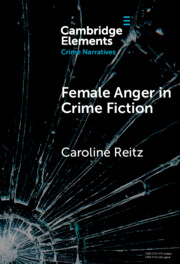Refine search
Actions for selected content:
171 results
Chapter 5 - Forgivingness
- from Part II - Virtues of Direct Caring
-
- Book:
- Attention to Virtues
- Published online:
- 25 July 2025
- Print publication:
- 14 August 2025, pp 85-119
-
- Chapter
- Export citation
Field Experiments Invoking Gloating Villains to Increase Voter Participation: Anger, Anticipated Emotions, and Voting Turnout
-
- Journal:
- British Journal of Political Science / Volume 55 / 2025
- Published online by Cambridge University Press:
- 11 August 2025, e104
-
- Article
-
- You have access
- Open access
- HTML
- Export citation
Chapter 12 - Anger Reinstated
- from Part III - Human Feeling and Ethical Development
-
-
- Book:
- Kant and Stoic Ethics
- Published online:
- 18 July 2025
- Print publication:
- 07 August 2025, pp 206-220
-
- Chapter
- Export citation
Consolidation and change: Exploring the impact of anger and network dynamics on inequality belief systems
- Part of
-
- Journal:
- Network Science / Volume 13 / 2025
- Published online by Cambridge University Press:
- 01 August 2025, e9
-
- Article
-
- You have access
- Open access
- HTML
- Export citation
Reciprocal relations between prolonged grief and anger in homicidally bereaved people involved in a criminal trial: a four-wave cross-lagged panel model
-
- Journal:
- Psychological Medicine / Volume 55 / 2025
- Published online by Cambridge University Press:
- 18 June 2025, e169
-
- Article
-
- You have access
- Open access
- HTML
- Export citation
7 - Two Accounts of Guilt in Freud
- from Introduction to Part III: Synthesis and Atonement
-
- Book:
- Rethinking Criminal Justice
- Published online:
- 17 May 2025
- Print publication:
- 05 June 2025, pp 149-167
-
- Chapter
- Export citation
Chapter 16 - Talking with Patients about Pregnancy Loss
-
-
- Book:
- Early Pregnancy
- Published online:
- 16 April 2025
- Print publication:
- 08 May 2025, pp 162-172
-
- Chapter
- Export citation
The impact of caregiver burden and associated factors on trait anger levels and anger expression styles in family caregivers of palliative care patients
-
- Journal:
- Palliative & Supportive Care / Volume 23 / 2025
- Published online by Cambridge University Press:
- 22 April 2025, e100
-
- Article
-
- You have access
- Open access
- HTML
- Export citation
Views on Men Behaving Badly: Male Public Opinion and the 2021 Capitol Insurrection
-
- Journal:
- Journal of Race, Ethnicity and Politics / Volume 10 / Issue 1 / March 2025
- Published online by Cambridge University Press:
- 17 March 2025, pp. 199-220
-
- Article
- Export citation
9 - The Parable of the Prodigal Son (Lk 15:11–32)
-
- Book:
- Luke's Unique Parables
- Published online:
- 28 February 2025
- Print publication:
- 06 March 2025, pp 104-121
-
- Chapter
- Export citation
10 - Moral Emotions
- from Part II - Thinking and Feeling
-
-
- Book:
- The Cambridge Handbook of Moral Psychology
- Published online:
- 20 February 2025
- Print publication:
- 27 February 2025, pp 222-247
-
- Chapter
- Export citation
Revisiting Response-Dependent Responsibility
-
- Journal:
- Dialogue: Canadian Philosophical Review / Revue canadienne de philosophie / Volume 63 / Issue 3 / December 2024
- Published online by Cambridge University Press:
- 23 January 2025, pp. 433-446
-
- Article
-
- You have access
- Open access
- HTML
- Export citation
The Rationality of Emotions Across Time
-
- Journal:
- Dialogue: Canadian Philosophical Review / Revue canadienne de philosophie , First View
- Published online by Cambridge University Press:
- 14 January 2025, pp. 1-18
-
- Article
-
- You have access
- Open access
- HTML
- Export citation
Speaking Truth to Power Structures: Integrity and Identity in Ecclesiology
-
- Journal:
- Journal of Anglican Studies / Volume 22 / Issue 2 / November 2024
- Published online by Cambridge University Press:
- 13 January 2025, pp. 379-400
-
- Article
- Export citation
A Philosopher goes to the Therapist
-
- Journal:
- Journal of the American Philosophical Association / Volume 11 / Issue 2 / June 2025
- Published online by Cambridge University Press:
- 10 January 2025, pp. 269-286
-
- Article
-
- You have access
- Open access
- HTML
- Export citation

Female Anger in Crime Fiction
-
- Published online:
- 01 December 2024
- Print publication:
- 12 December 2024
-
- Element
- Export citation
1 - Power of Anger
-
- Book:
- The Anger Rule
- Published online:
- 15 November 2024
- Print publication:
- 21 November 2024, pp 1-14
-
- Chapter
- Export citation
2 - Anger Rule
-
- Book:
- The Anger Rule
- Published online:
- 15 November 2024
- Print publication:
- 21 November 2024, pp 15-40
-
- Chapter
- Export citation
5 - Racial Differences in Anger Expression
-
- Book:
- The Anger Rule
- Published online:
- 15 November 2024
- Print publication:
- 21 November 2024, pp 100-120
-
- Chapter
- Export citation
3 - Angry Black Politicians?
-
- Book:
- The Anger Rule
- Published online:
- 15 November 2024
- Print publication:
- 21 November 2024, pp 41-64
-
- Chapter
- Export citation
